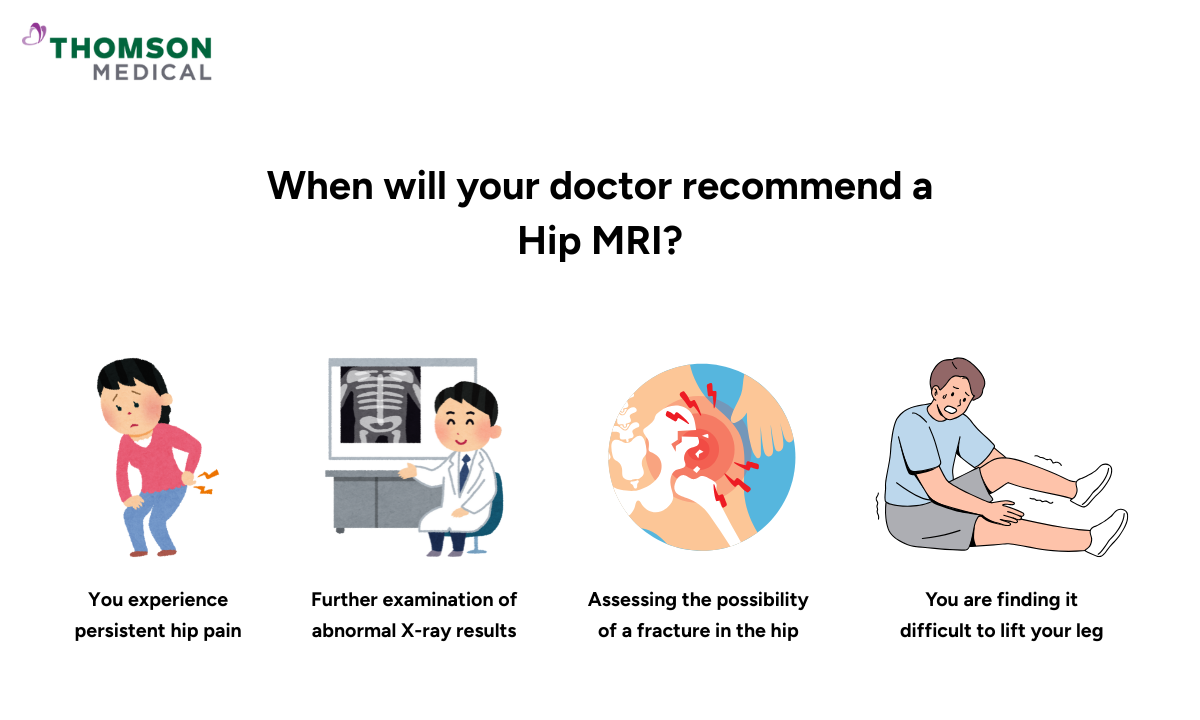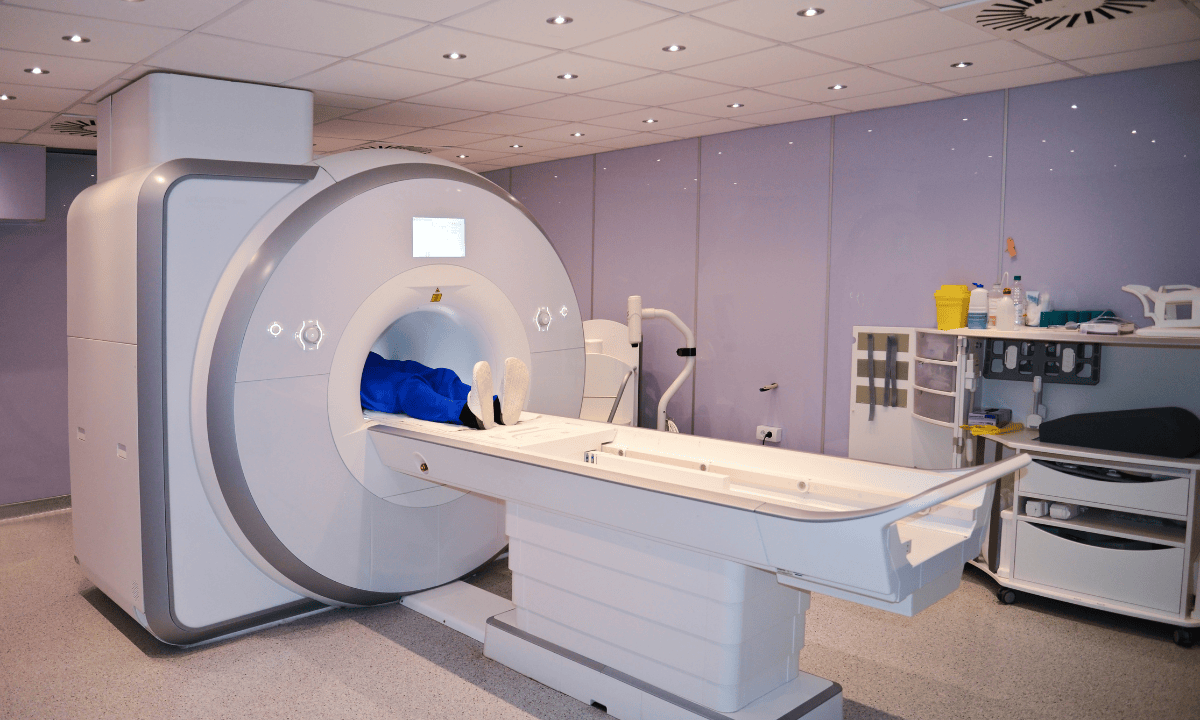Do your hips feel stiff when you wake up, or are you currently experiencing hip pain that is affecting your daily life? Many people assume that hip problems only affect older adults, but this is not always the case. Contrary to popular belief, hip conditions can affect people of all ages, especially if you lead an active lifestyle.
To find out what is causing your pain and discomfort, your doctor may recommend a magnetic resonance imaging (MRI) scan. This imaging technique creates detailed and accurate images of your hip joint and the surrounding structures. An MRI scan will help your doctor develop an effective treatment plan and prevent your hip condition from getting worse.
What is a hip MRI?
A hip MRI scan is a medical imaging test used to create detailed images of structures that make up your hip joint, including bones, cartilage, muscles, tendons, blood vessels, and ligaments. It can also provide detailed images of nearby structures, such as the sacroiliac joints that connect your lower back (lumbar spine) to your pelvis.
Your healthcare provider will use the MRI scan to make an accurate diagnosis and monitor your condition, allowing them to create a treatment plan tailored for you. It can also help determine whether your hip condition originates from other nearby structures. This helps to narrow down the list of potential causes.
Unlike X-rays or CT scans, this imaging technique uses a strong magnetic field and radio waves instead of radiation. As no radiation is involved, this imaging exam is safe for repeated assessments when necessary, and it provides more detailed images of soft tissues than other imaging methods.
When will your doctor recommend a hip MRI?

Your doctor may recommend a hip MRI scan in the following scenarios:
You’re experiencing persistent pain and discomfort in your hip.
There is suspicion of soft tissue damage, such as tendon, cartilage, or ligament tears.
You’re having difficulty lifting your leg and feel stiff and weak in your hip.
You experience hip and lower back pain when walking, climbing stairs, or sitting down.
Your doctor suspects degenerative joint disorders, such as arthritis.
Your doctor suspects other medical conditions, such as hip labral tears (damage to the ring of cartilage that lines the hip socket).
Further examination of abnormal X-ray results.
Evaluating other potential causes of pain or discomfort, such as muscle strain.
Assessing any bone fractures or bruising that might not be visible in other imaging tests.
Further examination to determine whether there is inflammation of a fluid-filled sac (bursa) within the hip joint.
Assessing the extent of injuries or conditions affecting the hip joint after trauma or surgery.
If you are experiencing any conditions mentioned above and would like further information or a second opinion, schedule an appointment with Thomson Medical. Our specialist can help assess your condition, explain your treatment options, including hip MRI scans, and create a tailored care plan for you.
How do I prepare for a hip MRI?
Preparing for an MRI scan is relatively straightforward, and your healthcare provider will provide you with instructions to help you prepare. A radiology technologist, a professional with training and certification to operate the MRI equipment, performs this imaging test.
Here are some general guidelines to help you prepare:
Clothing:
You may be asked to change into a hospital gown prior to the scan, which will be provided by your healthcare provider.
Metal objects:
Inform the technologist if you have any metal implants or other medical devices, such as pacemakers or artificial joints, as these can heat due to the magnetic fields of the MRI scanner and pose a safety risk.
You should also remove any jewellery, dentures, piercings, watches, or other metal objects, as they can interfere with the scan.
Medications:
Bring a list of any medications you are taking, as some may need to be temporarily stopped before the procedure.
Contrast dye:
If your doctor orders a contrast-enhanced MRI, you may need to be injected with a contrast dye (gadolinium) to improve the visibility of the soft tissue around your lumbar vertebrae.
However, if you have a kidney condition, you should inform your healthcare provider. They may perform a blood test prior to the scan to evaluate your kidney function and assess whether it is safe to use a contrast dye.
Pregnancy:
If you are pregnant or think you might be, tell your doctor or technologist before the scan.
If you are anxious about being in enclosed spaces (claustrophobia), talk to your healthcare provider. You may be given a sedative before the procedure to help you relax during the scan
Please don't hesitate to ask your doctor or technologist any questions you may have. They will be able to answer your questions and ensure that your MRI scan is performed safely and smoothly, putting your mind at ease.
How does the test work?

Following the preparation stage above, the procedure will begin and usually lasts around 30 to 45 minutes. During the scan, you can expect the following:
If a gadolinium contrast agent is required before the scan, your technologist will inject it through an IV into your arm vein.
You will then be asked to lie down on a table that slides into a large, tubular machine that looks like a tunnel.
When the scan starts, the MRI machine will make loud tapping or thumping sounds. You'll be given earplugs or headphones to wear before the procedure to protect your hearing.
During the scan, it's important to stay still to avoid a distorted image; you might also be asked to hold your breath briefly.
If there are issues, you can use the intercom to contact the MRI radiologist in another room.
You won't require a recovery period if you weren't given any sedatives for the MRI scan. You can return home and resume your normal activities immediately. However, if you have had a sedative for the scan, you will need to recover from its effects before you can go home safely.
If your scan requires a contrast dye, you will usually need to drink plenty of fluids to help flush the dye through your urine.
What are the potential risks of this medical imaging test?
Although MRI scans are generally safe, there are some potential risks you need to be aware of:
The loud noise produced by the MRI scanner can be uncomfortable, particularly if the scan takes more than an hour
If you're someone who gets anxious in small spaces (claustrophobia), you might feel uneasy during your MRI scan.
If your scan requires a contrast agent, some people may rarely experience an allergic reaction to gadolinium. Symptoms may include nausea, a metallic taste in the mouth, and an allergic reaction such as rashes, flushed skin, and shortness of breath.
People with metal implants, pacemakers, or other devices may need special precautions or can't have an MRI.
You may feel nervous or stressed while lying still in the MRI machine for a long periods of time.
Hip MRI cost in Singapore
The cost of a hip MRI scan in Singapore depends on several factors. These factors include whether or not contrast dye is used, how complicated the scan is, and whether it is performed in a public or private healthcare institution. At private clinics, the cost of a hip MRI scan in Singapore generally ranges from SGD 900 to 1,000 per scan.
For Singaporeans, the Ministry of Health (MOH) provides subsidies of up to 70% for patients at public specialist outpatient clinics. Additional subsidies of up to 50% and 25% are available for Pioneer and Merdeka Generation seniors, respectively.
In addition to these subsidies, patients can use their MediSave to offset up to SGD $300 per year for outpatient diagnostic scans, including MRI scans. Seniors aged 60 and above can withdraw an additional SGD $300 per year from MediSave for MRI scans under the Flexi-MediSave scheme.
The information provided above is intended for general reference only. To learn more about subsidies for MRI scans, please refer to Singapore’s MOH website. Schedule an appointment with our specialists at Thomson Medical today for a detailed price breakdown and a personalised care plan.
FAQ
What does an MRI of the hip show?
A hip MRI shows high-quality images of all structures in and around your hip joint, including bones, cartilage, blood vessels, ligaments, muscles, and other soft tissues. It can detect fractures, tears (such as labral tears), joint degeneration, inflammation, and conditions like bursitis, arthritis, or soft tissue injuries.
The scan can also reveal problems that may not be visible on other imaging techniques, helping your doctor make a detailed diagnosis of your condition.
How long does a hip MRI usually take?
A hip MRI usually takes 30 to 45 minutes, depending on the complexity of your case and whether contrast dye is required. If your scan includes multiple views or requires additional imaging sequences, it may take slightly longer.
Your radiology technologist will inform you of the expected duration before your procedure begins.
Is MRI necessary for hip pain?
An MRI is not always necessary for hip pain. Your doctor will typically start with a physical examination and may recommend X-rays or other imaging techniques first.
However, if soft tissue injuries, cartilage damage, or specific conditions like labral tears are suspected, an MRI becomes essential for obtaining quality images that help diagnose the exact cause of your pain.
Can MRI show nerve damage in the hip?
Although an MRI scan is effective at showing structural damage to tissues, such as muscles, tendons, and cartilage, it is not the best tool for diagnosing nerve damage.
However, it can indirectly reveal evidence of nerve compression or inflammation, particularly in cases of conditions such as herniated discs or sciatica, which can affect the hip area.
Which is better, an MRI or a CT scan for the hip?
An MRI scan is generally considered a better method than a CT scan for evaluating soft tissue injuries in the hip, such as damage to ligaments, tendons, and cartilage. MRI scans provide better image quality of soft tissues and do not use radiation, making them safer for repeated assessments.
CT scans, on the other hand, are better suited to assessing bone fractures or complex bone-related conditions. For most hip problems involving soft tissue, MRI is the preferred imaging method.
Do you wear clothes for a hip MRI?
You may be asked to change into a hospital gown before your hip MRI scan, which will be provided by the healthcare facility. This ensures that no metal objects from clothing (such as metal fasteners, buttons, or underwire) interfere with the MRI's magnetic field.
You'll need to remove all jewellery, watches, and metal objects before the scan. Your technologist will provide clear instructions about what to wear or remove before your procedure.
The information provided is intended for general guidance only and should not be considered medical advice. To get personalised recommendations based on your medical conditions, schedule an appointment with Thomson Medical.
For more information, contact us:
Thomson Medical Concierge
- 8.30am - 5.30pm
- WhatsApp: 9147 2051
Need help finding the right specialist or booking for a group?
Our Medical Concierge is here to help you. Simply fill in our form, and we'll check and connect you with the right specialist promptly.
Notice:
The range of services may vary between Thomson clinic locations. Please contact your preferred branch directly to enquire about the current availability.
Get In Touch